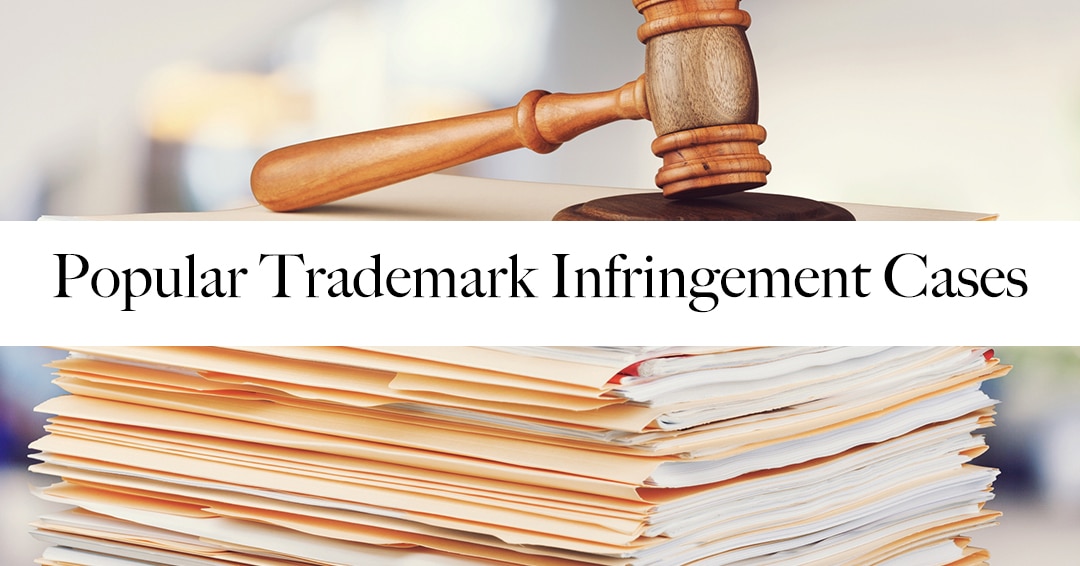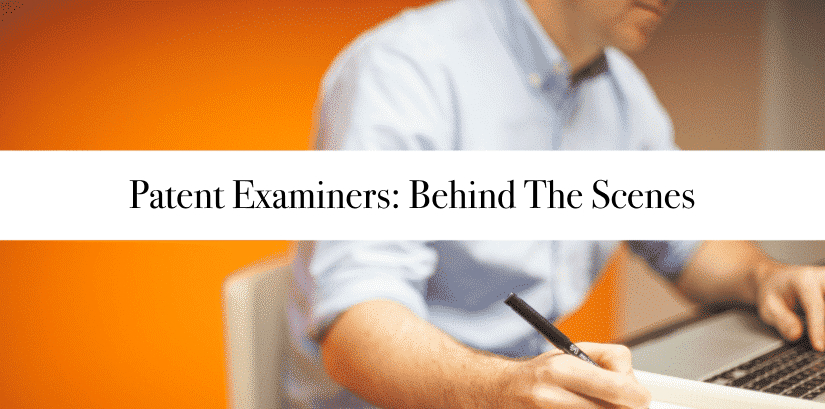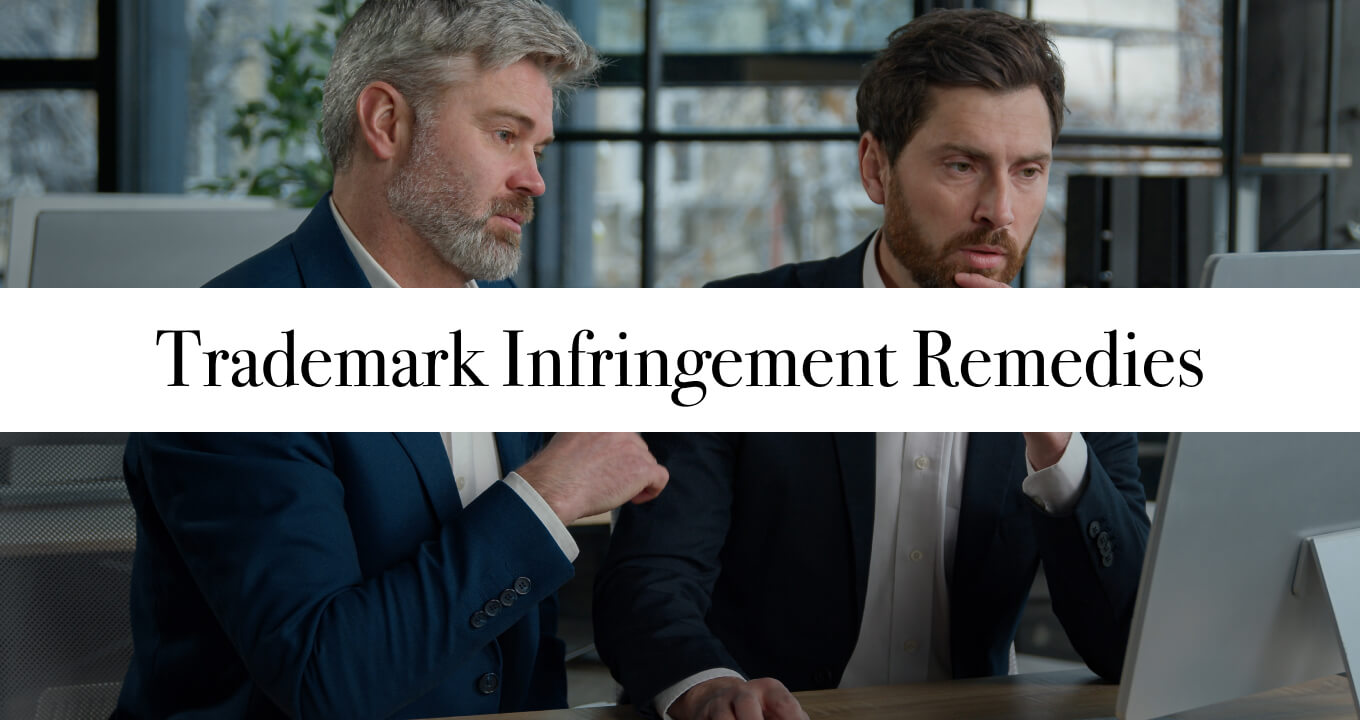Originally posted on October 17, 2023 @ 9:00 am
Trademark conflicts are gaining attention as companies globally vie for the rights to the most appealing brand names and logos. Grasping the nuances of trademark infringement is essential for both businesses and consumers. Delve into the specifics and learn why this matter holds importance for anyone who appreciates a strong brand.
So, in this article, we will explore the importance of trademarks, the 30 infringement cases that changed the game of trademarks, the legal framework surrounding trademark infringements, and the process you would have to go through in the case you find yourself in that situation.
But before delving into the details and the actual case studies, let’s further understand what trademark infringement is, and what factors apply as infringement in today’s legal framework to further understand what we are discussing.
What is Trademark Infringement?
Trademark infringement is the unauthorized use of a trademark or trade dress in a way that is likely to cause confusion, deception, or a mistake about the source of goods or services, which is a violation of the exclusive rights granted to the owner of the trademark.
But to further understand how trademark infringement works, let’s take a look at the factors that apply to infringement and determine whether or not the infringement case is valid and the infringing party is in the wrong.
The Factors that Apply to Trademark Infringement
When talking about trademark infringement, there are multiple factors that legal organizations need to take into account in order to fully understand if the case is valid or not. So, let’s take a closer look at what constitutes trademark infringement.
- If the mark or logo that identifies your business has a high likelihood of confusion with a previous trademark,
- Your mark cannot look or sound like a registered trademark, given that the court also looks at phonetic similarities.
- If the goods or services offered by the infringing party are related to those covered by the original trademark registration, it increases the likelihood of confusion.
It is important to note that trademark infringement can occur not only through the use of identical or similar marks but also through the use of marks that create a likelihood of confusion, which means that even if the marks are not identical, it can still be considered trademark infringement.
So, now that we have understood what trademark infringement is and the factors that apply to it, let’s take a look at the 30 trademark infringements that changed the technological industry and set up the legal framework for infringement as we know it today.
The 30 Trademark Infringement Cases that Changed Tech
Throughout the years, there have been a plethora of infringement cases that have made the headlines. But let’s take a closer look at the 30 trademark infringement cases that changed the tech industry, to further illustrate how important a trademark is for your business:
| Infringement Case | Details | Impact |
| Apple vs. Samsung (2012) | Apple accused Samsung of copying various design and utility patents in their smartphones and tablets, particularly focusing on the iPhone and iPad. | The case highlighted the importance of design patents and intellectual property protection in the tech industry and resulted in a jury award of over $1 billion in favor of Apple. |
| Facebook vs. ConnectU (2008) | Mark Zuckerberg was accused of stealing the idea and code for Facebook from the founders of ConnectU. | It raised questions about the origins of Facebook and the protection of intellectual property in the tech startup world. |
| Oracle vs. Google (2012) | Oracle sued Google, claiming that Google’s use of Java APIs in its Android operating system violated their copyrights. | It highlighted the importance of fair use in software development and copyright infringement cases involving APIs. |
| Nintendo vs. Atari (1984) | Nintendo sued Atari Games, alleging that Atari copied Nintendo’s Donkey Kong arcade game. | The case established the importance of trademark and copyright protection for video game characters and gameplay concepts. |
| Sega Enterprises vs. Accolade (1992) | Sega sued Accolade for reverse engineering Sega Genesis games to make them compatible with their gaming console. | It clarified the legality of reverse engineering in the context of compatibility and fair use, affecting the development of software. |
| Microsoft vs. Lindows (2004) | Microsoft sued Lindows, arguing that the name “Lindows” for a Linux-based operating system was too similar to “Windows.” | It highlighted the significance of trademark protection for tech companies and resulted in Lindows changing its name to “Linspire.” |
| Polaroid vs. Kodak (1977) | Polaroid sued Kodak for their instant camera technology and for trade dress infringement. | It helped establish the concept of trade dress in trademark law and set precedents in trademark protection. |
| Qualcomm vs. Broadcom (2007) | Qualcomm sued Broadcom for patent infringement in the semiconductor industry. | It raised questions about patent licensing and antitrust issues in the tech industry. |
| Aereo vs. ABC (2014) | Aereo was a startup that provided a cloud-based TV streaming service that was accused of copyright infringement by ABC. | The case raised fundamental questions about the legality of cloud-based streaming services and the implications for the future of TV. |
| BlackBerry vs. NTP (2006) | The maker of BlackBerry smartphones was sued by NTP for patent infringement. | It highlighted the importance of intellectual property in the mobile technology industry. |
| Apple vs. Microsoft (1994) | Apple sued Microsoft alleging that Microsoft’s Windows operating system copied elements of Apple’s graphical user interface. | It underscored the importance of GUI design elements in tech products and contributed to the ongoing rivalry between Apple and Microsoft. |
| Sony vs. Universal Studios (1984) | Universal Studios sued Sony arguing that the devices could be used to infringe upon their copyrights by recording television shows. | It played a pivotal role in shaping copyright law for technology products, ensuring that devices with legitimate uses could not be held liable for infringement. |
| Monster Energy vs. Beastie Boys (2014) | Monster Energy sued the Beastie Boys alleging unauthorized use of their music in a promotional video. | It highlighted the importance of copyright protection in the entertainment industry. |
| Tiffany & Co. vs. eBay (2010) | Tiffany & Co. sued eBay claiming that eBay did not do enough to prevent the sale of counterfeit Tiffany jewelry on its platform. | It emphasized the responsibility of online marketplaces to combat counterfeit goods. |
| Lumia vs. Microsoft (2012) | Microsoft and Nokia had a dispute over the “Lumia” brand. | It highlighted the importance of protecting trademarks in the tech industry. |
| Intellectual Ventures vs. Capital One | Intellectual Ventures sued Capital One alleging that Capital One had infringed upon various patents. | It underscored the need for patent reform and clarity. |
| Warner Bros. vs. RDR Books (2008) | Warner Bros. sued RDR Books over the publication of a Harry Potter encyclopedia. | It clarified the boundaries of fair use in creating reference materials related to copyrighted works. |
| Amazon vs. Barnes & Noble (1999) | Amazon sued Barnes & Noble asserting that Barnes & Noble’s “1-Click” online shopping feature infringed on Amazon’s patent. | It highlighted the role of patents in e-commerce on patenting of seemingly simple online shopping processes. |
| Rambus vs. Infineon (2001) | Rambus sued Infineon alleging that Infineon used Rambus’s patented memory chip technology without proper licensing. | It raised questions about patent licensing practices and standards-related patents. |
| TiVo vs. EchoStar (2011) | TiVo sued EchoStar (Dish Network) for patent infringement related to DVR technology. | It underscored the importance of protecting intellectual property in the media and entertainment industry. |
| Verizon vs. Vonage Holdings (2007) | Verizon sued Vonage for patent infringement related to Voice over IP (VoIP) technology. | It highlighted the importance of patent protection in the telecommunications industry. |
| Bayer vs. Belmora (2015) | Bayer sued Belmora alleging that Belmora’s use of “Flanax” for pain relief medication caused confusion with Bayer’s “Aleve” brand. | It addressed issues related to trademark rights, foreign brand recognition, and the enforcement of trademarks in the United States. |
| Skydive Arizona, vs. Quattrocchi (2010) | Skydive Arizona and Quattrocchi, an individual, had a dispute over the use of Skydive Arizona’s trademark in online advertising. | It emphasized the importance of protecting trademarks and the potential legal issues surrounding keyword advertising. |
| Spamhaus vs. e360 Insight (2006) | Spamhaus was sued by e360 Insight for defamation related to spam email. | It brought attention to the legal issues surrounding spam and the use of trademarks in online communication. |
| Qualtrics vs. SMR Research (2020) | Qualtrics and SMR Research had a dispute over the use of the term “Qualtrics.” | It highlighted the importance of trademark protection for software and technology companies. |
| CyberSitter vs. China (2009) | CyberSitter sued China for alleged cyberattacks and trademark infringement. | It underscored the challenges of pursuing legal action against foreign entities. |
| Lumos Labs vs. Smart Financieros (2018) | Lumos Labs, the creator of the “Lumosity” brain-training app, and Smart Financieros had a dispute over their tech. | It demonstrated the importance of protecting the brand identity of tech companies, particularly those in the mobile app industry. |
| Viacom vs. YouTube (2010) | Viacom sued YouTube alleging that they allowed users to upload and share copyrighted content. | It raised questions about the liability of online platforms for user-generated content. |
| Apple Corps. vs. Apple Computer, (2006) | It was a dispute between the record label, Apple Corps Ltd., and Apple Computer over the use of the “Apple” trademark in the music industry. | It marked the resolution of a long-running trademark dispute and addressed the coexistence of the Apple brand in both the music and technology industries. |
| AT&T vs. Verizon (2009) | It was a dispute involving advertising campaigns by AT&T and Verizon, with claims of false advertising. | It highlighted the importance of truth in advertising and the potential legal consequences of misleading marketing. |
As you can see, there are so many cases to look at that trademarking your business patents would only do you a service in protecting your intellectual and material property. But to further understand why trademarks are so important, let’s take a look at a few more details.
The Importance of Trademarks
Trademarks play a crucial role in the business world by distinguishing the goods and services of one company from those of others, given that they provide valuable brand recognition and help businesses build customer loyalty.
Furthermore, they also serve as indicators of quality and source, allowing consumers to make informed purchasing decisions when it comes to deciding between brands, which encourages competition and innovation from businesses all around the world.
So, now that we have understood what trademark infringement is, the factors that apply to infringement, and why it is so important to trademark your logo or slogan, let’s get into how the legal framework of trademark infringement is composed to better understand how it works.
The Legal Framework of Trademark Infringement
Trademark infringement cases are governed by a legal framework that includes both national and international laws, and each country has its own set of trademark laws and regulations to protect the rights of trademark holders.
These laws are designed to safeguard the distinctiveness of a brand, ensuring that consumers can easily differentiate the mark between different products in the marketplace while also giving owners the exclusive right to use their marks in connection with specific goods or services. Now let’s take a closer look at some of the frameworks that govern infringement laws.
- The Paris Convention for the Protection of Industrial Property aims to ensure that trademarks are protected internationally, promote fair competition, and prevent confusion in the global marketplace.
- TRIPS is a comprehensive agreement administered by the World Trade Organization that sets out minimum standards of protection and enforcement for various forms of intellectual property, including trademarks.
- The Madrid Agreement from the International Registration of Marks and the Madrid Protocol simplify the process of obtaining trademark protection, reducing costs and administrative burdens for trademark owners.
- The WIPO Arbitration and Mediation Center provides a neutral and efficient forum for resolving conflicts between trademark owners, which is faster and less costly than traditional litigation.
These legal mechanisms aim to safeguard the rights of trademark holders and promote fair competition in the global marketplace. But what is the process of a trademark infringement case in the first place? Let’s get into it!
The 8 Step Process of a Trademark Infringement Case
The process of a trademark infringement case typically involves several stages, from identifying infringement to initiating legal proceedings. So let’s take a closer look at these stages to fully understand the process.
- The first step in any infringement case is monitoring the marketplace for unauthorized use of their mark.
- If evidence is found, it must be thoroughly documented by conducting market research and engaging the services of intellectual property professionals.
- They must also look out for reports from third parties to identify potential infringements, which can provide valuable insights and help in building a strong case.
- Once trademark infringement is identified, the trademark owner can initiate legal proceedings to enforce their rights.
- The first legal step is to send a cease-and-desist letter to the infringing party, which normally solves the situation.
- If the alleged infringer does not comply with the cease-and-desist letter, the trademark owner may choose to file a lawsuit, which allows them to seek damages or injunctions.
- Both parties will then have the opportunity to present their arguments to the court, allowing them to make a decision based on the merits of the case.
- If the case doesn’t get resolved, they proceed to mediation or arbitration, which can provide a more efficient and cost-effective means of resolving trademark disputes.
It is important to note that the process of a trademark infringement case can be complex and time-consuming and that it requires careful preparation, thorough research, and skilled legal representation.
Trademark owners should consult with experienced intellectual property attorneys to navigate the intricacies of the legal system and maximize their chances of success. Now let’s delve into the impact of trademark infringement to further clarify this topic.
The Impact of Trademark Infringement
Trademark infringement is a serious offense that can have significant consequences for both the infringers and the original trademark holders. For example, when found guilty of infringing on someone else’s trademark, businesses may be required to pay substantial damages to the trademark owner.
These damages can include compensatory damages, which aim to reimburse the trademark owner for any financial losses suffered as a result of the infringement, as well as punitive damages, which are meant to punish the infringer for their wrongful actions.
Another consequence that infringers could face is negative publicity and harm to their business reputation, given that trademark infringement cases often attract media attention and the public may view the infringers as unethical or dishonest, which can lead to a loss of trust and credibility.
Furthermore, trademark infringement can significantly affect the original trademark holder as well, given that it could lead to a potential loss of sales, a dilution of their brand value, and a diminishment of the distinctiveness and uniqueness of their brand.
This could also potentially lead to further financial burdens for the trademark owner in their efforts to restore their reputation and market position, which can involve launching new marketing campaigns, strengthening their brand identity, and reestablishing trust with consumers.
Trademark infringement has far-reaching impacts on both infringers and the original trademark holders. It is crucial for businesses to understand the importance of respecting and protecting trademarks to avoid these detrimental effects.
The 7 Measures to Prevent Trademark Infringement
Companies can implement several measures to minimize the risk of trademark infringement. Let’s take a look at some of the best strategies to prevent trademark infringement:
- Register your trademark with the appropriate authorities to have a legal presumption of ownership and exclusive rights to your logo.
- When a trademark is registered, provide a public notice of the ownership and rights associated with the mark, which serves as a deterrent to potential infringers.
- Seek registration in relevant jurisdictions and monitor their trademarks to identify and address any potential infringements.
- Regularly monitor the marketplace to identify potential infringements early by using online monitoring tools, which can help companies keep track of new trademark registrations that may conflict with their own.
- Engage intellectual property professionals, such as trademark attorneys or investigators, who can provide expertise and resources to conduct thorough investigations into potential infringements.
- Establish clear internal procedures to monitor and enforce trademark rights, which include educating employees, providing guidelines for proper trademark usage, and implementing a system for reporting potential infringements.
- Take immediate action against infringers to prevent further harm and protect the brand’s integrity.
By implementing these measures, companies can significantly reduce the risk of trademark infringement and safeguard their valuable brand assets, which not only helps preserve a company’s reputation but also ensures its continued success in the marketplace.
The Future of Trademark Infringement
With the advent of the digital age, new challenges have emerged, posing threats to intellectual property rights. So, let’s take a look at some of the future challenges that intellectual property is facing and what is being done to solve them.
| Challenge | Solution |
| Unauthorized sellers are counterfeiting products by creating and distributing fake products through various online platforms, harming the brand’s reputation and sales. | Companies must monitor online platforms and stay updated on technological advancements to adapt their strategies accordingly. |
| Cybersquatting, which involves registering domain names that are similar to established trademarks with the intention of profiting from the confusion it creates. | Implementing monitoring tools and employing dedicated teams to identify and report instances of cybersquatting can help mitigate the risks associated with these practices. |
| The rise of social media influencers and online marketplaces has created new avenues for unauthorized use of trademarks. | Companies must establish clear guidelines for the use of trademarks by influencers, and collaborate with online marketplaces to enforce strict policies against trademark infringement. |
By staying vigilant, adapting strategies, and implementing comprehensive protection measures, companies can navigate the ever-changing landscape of trademark infringement and safeguard their intellectual property rights.
Protect Your Trademarks from Infringement
In an increasingly competitive business environment, trademarks play a pivotal role in establishing and protecting a company’s identity and reputation. Understanding trademark infringement is vital for businesses seeking to safeguard their valuable intellectual property.
By comprehending the legal framework, implementing preventive measures, and staying prepared for future trends, companies can navigate the complex world of trademark infringement and safeguard their brands for years to come.






